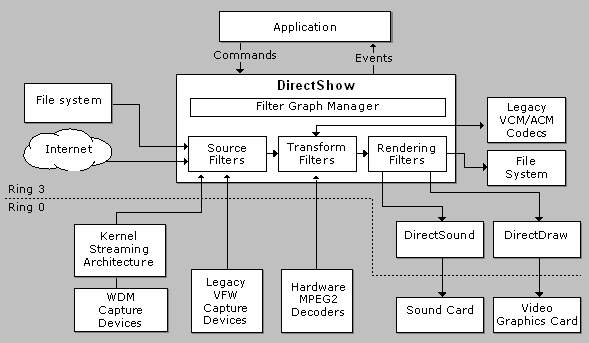
| Microsoft DirectX 9.0 |
The Challenge of Multimedia
Working with multimedia presents several major challenges:
The DirectShow Solution
DirectShow is designed to address each of these challenges. Its main design goal is to simplify the task of creating digital media applications on the Windows® platform, by isolating applications from the complexities of data transports, hardware differences, and synchronization.
To achieve the throughput needed to stream video and audio, DirectShow uses DirectDraw® and DirectSound® whenever possible. These technologies render data efficiently to the user's sound and graphics cards. DirectShow synchronizes playback by encapsulating media data in time-stamped samples. To handle the variety of sources, formats, and hardware devices that are possible, DirectShow uses a modular architecture, in which the application mixes and matches different software components called filters.
DirectShow provides filters that support capture and tuning devices based on the Windows Driver Model (WDM), as well as filters that support legacy Video for Windows (VfW) capture cards, and codecs written for the Audio Compression Manager (ACM) and Video Compression Manager (VCM) interfaces.
The following diagram shows the relationship between an application, the DirectShow components, and some of the hardware and software components that DirectShow supports.

As illustrated here, DirectShow filters communicate with, and control, a wide variety of devices, including the local file system, TV tuner and video capture cards, VfW codecs, the video display (through DirectDraw or GDI), and the sound card (through DirectSound). Thus, DirectShow insulates the application from many of the complexities of these devices. DirectShow also provides native compression and decompression filters for certain file formats.